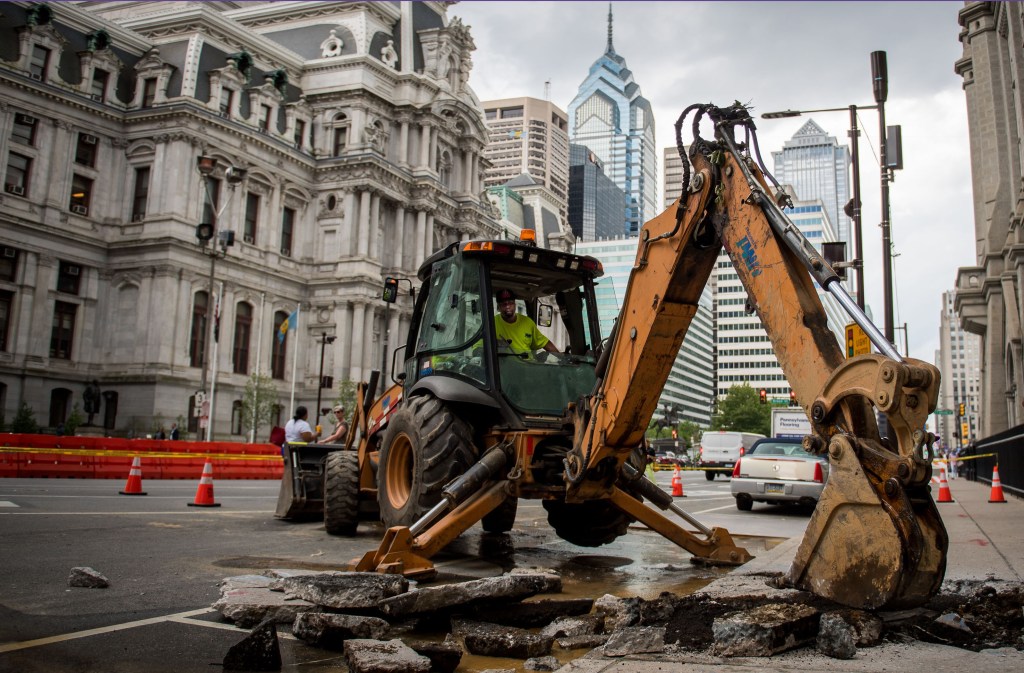Call our emergency hotline: (215) 685-6300
to report a main break, loss of water, or other water emergency.
What to expect if a water main breaks nearby
Main breaks can cause a loss of water pressure, or even temporary loss of service, as the main is shut down to isolate the emergency.
Affected customers are notified as soon as possible, usually with a door hanger on the front door of the property.
Most interruptions to water service are fixed within six to eight hours. In some cases, such as water main breaks that occur in the middle of the night, water is usually restored by the following day.

Don’t worry! Unless you’re told otherwise by a representative of PWD, your water is safe to drink.
How will PWD respond?
- IDENTIFY: What type of leak is happening? How urgent is the situation? Is it from a main or a customer water pipe? We may shut down the water to isolate the emergency. Specialized crews assist with the shutdown of large water main breaks.
- CONTAIN: An emergency crew shuts down the main if it is causing damage or flooding, and a repair crew is assigned. A PWD spokesperson may provide updates to the media, while a Field Supervisor on site keeps affected property owners informed. Generally, this occurs when there are multiple properties without water, significant damage and traffic disruptions.
- PINPOINT: If we need to dig, a call is made to PA One Call, and other utilities are marked, including gas, electric and other lines. If the leak is on PWD’s water main, we will arrange to have utilities marked and take steps to protect the public’s safety.
- REPAIR: If it’s our main, the repair crew digs, repairs or replaces the damaged pipe, and coordinates arrangements for traffic. Typical time is 8–12 hours from the time our crews begin working. This estimate may be shorter or longer depending on the situation.
Note: Permanent repairs to the road surface are handled by the Streets Department. - RESTORE: Repair crews flush the line, disinfect the main if needed, and patch the road.
Note: If property damage resulted from a main break, Risk Management claims representatives can help customers with potential damage claims.
Responding to main breaks
What to do after PWD’s crews finish working
Pipe replacement or repairs to water service near your home can allow sediment and debris to enter your pipes. Here are some tips for clearing debris from your water pipes after street repairs have been made:
- Flush your home plumbing for 30 minutes to clear debris from your pipes. Use your outdoor garden hose, a utility sink, or your bathtub, if possible. These generally have a larger capacity and do not have faucet aerator screens, which can trap debris. You only need to flush your pipes once.
- Clear faucet screens to remove debris that might cause clogs.
- Read our illustrated fact sheet showing how to clean pipes after construction work
Why do water mains break?
Water mains fail when the stresses placed upon them are greater than the strength of the pipe. Water mains don’t get stronger with time – in fact, they generally get weaker, due to internal or external corrosion.
Note: PWD’s last wooden mains were taken out of service in 1858.
External forces on a water main include:
- traffic loading
- temperature changes
- underground work that leads to direct or indirect impact to the pipe
The imbalance of stresses to the strength of a pipe may show itself in various ways, such as:
- joint leaks;
- pipe breaks; or
- service line detached from a main.
Types of Mains
Three different categories of pipe transport water from treatment plants to a customer’s property:
- Transmission Mains: large mains with a diameter of 16 inches or greater, used to move large amounts of water across the city between pumping stations and reservoirs
- Distribution Mains: smaller mains used to deliver water from transmission mains to customer service lines
- Service Connections: individual connections owned by property owner that bring water from the distribution mains into a building or house
How is PWD attempting to reduce water main breaks?
PWD has several ongoing programs to prevent main breaks and other pipe failures. We continually monitor and improve our infrastructure to minimize disruptions while continuing to provide safe and efficient service.
Main replacement
The goal of this program is to maintain a high level of water service and system reliability while still achieving a full, useful life for every water main. The main replacement program uses a scoring system to prioritize replacement and provide a systematic approach to the management of assets. Generally, the older the main and the more frequently it has experienced breaks, the higher the priority for its replacement.
See active and upcoming water main replacement projects →
Corrosion testing
Our corrosion testing and rehabilitation program also prevents breaks in large, cast iron transmission mains. This cleaning and relining program can reduce leaks and extend the useful life of transmission mains.
Cathodic protection
The cathodic protection program guards against exterior corrosion from soil conditions or stray electric current that may cause weak spots in the water mains. During main replacement or repair, inspectors determine if the conditions require cathodic protection for the new main.
Leak detection
Leak detection analysis focuses on non-visible leaks on both transmission and distribution mains. Acoustic devices are used to analyze one third of the city water mains each year. The deeper, larger transmission mains are investigated by a specialized leak detection company.